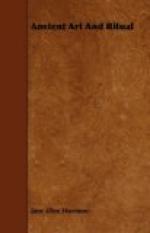Leaving the drama, we come in the next chapter to Sculpture; and here, too, we shall see how closely art was shadowed by that ritual out of which she sprang.
FOOTNOTES:
[35] See Bibliography at end for Professor Murray’s examination.
[36] Mr. Edward Bullough, The British Journal of Psychology (1912), p. 88.
[37] II, 15.
[38] See my Themis, p. 289, and Prolegomena, p. 35.
[39] De Cupid. div. 8.
[40] V, 66.
[41] Athen., VIII, ii, 334 f. See my Prolegomena, p. 54.
[42] Thanks to Mr. H.M. Chadwick’s Heroic Age (1912).
CHAPTER VI
GREEK SCULPTURE: THE PANATHENAIC FRIEZE AND THE APOLLO BELVEDERE
In passing from the drama to Sculpture we make a great leap. We pass from the living thing, the dance or the play acted by real people, the thing done, whether as ritual or art, whether dromenon or drama, to the thing made, cast in outside material rigid form, a thing that can be looked at again and again, but the making of which can never actually be re-lived whether by artist or spectator.
Moreover, we come to a clear threefold distinction and division hitherto neglected. We must at last sharply differentiate the artist, the work of art, and the spectator. The artist may, and usually indeed does, become the spectator of his own work, but the spectator is not the artist. The work of art is, once executed, forever distinct both from artist and spectator. In the primitive choral dance all three—artist, work of art, spectator—were fused, or rather not yet differentiated. Handbooks on art are apt to begin with the discussion of rude decorative patterns, and after leading up through sculpture and painting, something vague is said at the end about the primitiveness of the ritual dance. But historically and also genetically or logically the dance in its inchoateness, its undifferentiatedness, comes first. It has in it a larger element of emotion, and less of presentation. It is this inchoateness, this undifferentiatedness, that, apart from historical fact, makes us feel sure that logically the dance is primitive.
* * * * *




